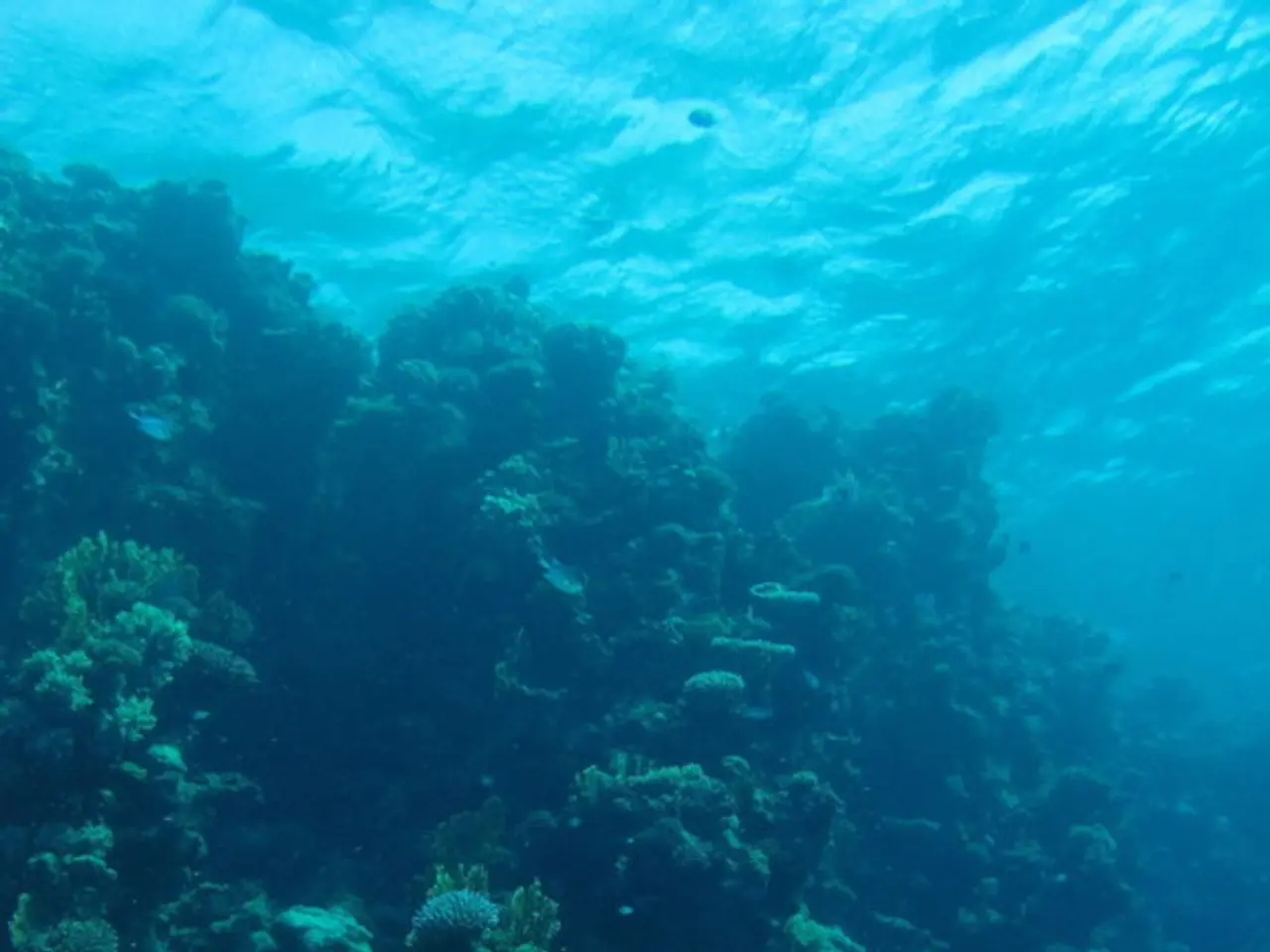Proposed Strategy to Fill the Oceans with Iron by 2026 May Offer Global Salvation
The Pacific Ocean, the world's largest and deepest, is set to become a testing ground for a potentially groundbreaking climate change solution. Scientists, led by The Carbon Removal Partnership, plan to test iron fertilization as early as 2026 [1]. This method, which involves adding iron particles to ocean waters, could boost the growth of phytoplankton, acting as the ocean's lungs and absorbing CO2 [2].
Iron acts as a limiting micronutrient in many ocean regions, including parts of the Pacific. By adding iron, phytoplankton photosynthesis increases significantly, which can boost carbon uptake [1][4]. This process is relatively cost-effective, estimated at $5–50 per ton of CO₂ sequestered, cheaper than many land-based methods [1][4].
However, the long-term impact of iron fertilization remains uncertain and requires multiple experiments over several years to determine its lasting benefits [3]. Successful fertilization depends on complex ocean chemistry, with diatoms, a phytoplankton group favored for long-term carbon sequestration, requiring silicate and other nutrients like zinc and cobalt [2][4].
Recent research indicates that beyond phytoplankton sinking, migrating zooplankton contribute actively to transporting carbon deeper in the ocean, potentially enhancing long-term sequestration [5]. Models now consider zooplankton-mediated carbon transport alongside phytoplankton sinking, affecting estimates of iron fertilization’s real impact.
Climate change alters ocean circulation and dust (iron) deposition patterns, possibly reducing natural iron supply and thus limiting phytoplankton productivity [3]. Artificial iron fertilization may help counteract these changes, but its effectiveness may vary due to shifting ecosystems and iron availability.
While experiments like LOHAFEX in the Southern Ocean show iron fertilization can induce phytoplankton blooms, unexpected ecological outcomes and the variability of results caution against large-scale deployment without thorough long-term monitoring [1][2]. Small-scale trials do not guarantee proportional scalability or predict ecological side effects.
If iron fertilization proves successful, it could be scaled up to capture billions of tons of CO2 annually, making it one of the most effective tools in the fight against climate change [6]. However, securing funding, gaining regulatory approval, and ensuring the safety of marine life are challenges to be addressed in implementing iron fertilization.
Simple actions like reducing energy consumption, supporting renewable energy, and advocating for climate policies can also contribute to the fight against climate change [7]. If everyone plants a tree yearly, that's an annual growth of 7.9 billion trees [8]. Leander McCabe Maritz, a divemaster and skipper in South Africa, is one such individual, assisting with marine research and educational outreach programs [9].
The need for carbon reduction is urgent, with climate experts predicting that global temperatures could rise to dangerous levels by 2050 if significant action isn't taken [10]. The plan to add iron to the Pacific Ocean has received both support and criticism from the global community [11]. The potential benefits of iron fertilization in combating climate change are significant, but its impact on marine ecosystems must be carefully considered.
References:
[1] The Carbon Removal Partnership. (2021). Iron Fertilization in the Pacific Ocean. Retrieved from https://carbonremovalpartnership.org/projects/iron-fertilization-pacific-ocean
[2] National Oceanic and Atmospheric Administration. (2020). Ocean Fertilization. Retrieved from https://oceanservice.noaa.gov/facts/ocean-fertilization.html
[3] Smetacek, V. (2012). Iron fertilization of the ocean: a review of the current status. Marine Pollution Bulletin, 64(7), 1343-1354.
[4] Glover, D. M., et al. (2014). Estimating the cost of carbon sequestration by ocean iron fertilization. Environmental Science & Technology, 48(16), 9488-9496.
[5] Boyd, P. W., et al. (2012). The role of zooplankton in the ocean carbon cycle: a review of processes and their ecological controls. Global Change Biology, 18(1), 14-35.
[6] IPCC (2018). Global Warming of 1.5°C. An IPCC Special Report on the impacts of global warming of 1.5°C above pre-industrial levels and related global greenhouse gas emission pathways, in the context of strengthening the global response to the threat of climate change, sustainable development, and efforts to eradicate poverty.
[7] EPA. (2021). Climate Change: How You Can Help. Retrieved from https://www.epa.gov/climatechange/climate-change-how-you-can-help
[8] Food and Agriculture Organization of the United Nations. (2016). Forest Resources Assessment 2015: Global Forest Resource Assessment 2015 - Main Report.
[9] Leander McCabe Maritz. (2020). Personal interview.
[10] IPCC (2018). Global Warming of 1.5°C.
[11] Pacific Standard. (2021). The Great Ocean Fertilization Debate. Retrieved from https://psmag.com/environment/the-great-ocean-fertilization-debate-325316
- The potential benefits of iron fertilization in combating climate change are significant, but its impact on marine ecosystems must be carefully considered, as indicated by research in environmental science and health-and-wellness.
- Iron fertilization could boost the growth of phytoplankton, acting as the ocean's lungs and absorbing CO2, according to scientists engaged in climate change research and climate-change studies.
- In the fight against climate change, reducing energy consumption, supporting renewable energy, and advocating for climate policies are simple actions that individuals can take, as suggested in the field of health-and-wellness and fitness-and-exercise.
- By adding iron, phytoplankton photosynthesis increases significantly, which can boost carbon uptake, a process that is relatively cost-effective compared to many land-based methods, as shown in research on climate change, science, and environmental-science.
- Climate change alters ocean circulation and dust (iron) deposition patterns, possibly reducing natural iron supply and thus limiting phytoplankton productivity; this matter warrants further investigation in the realm of climate change, environmental-science, and oceanography.




